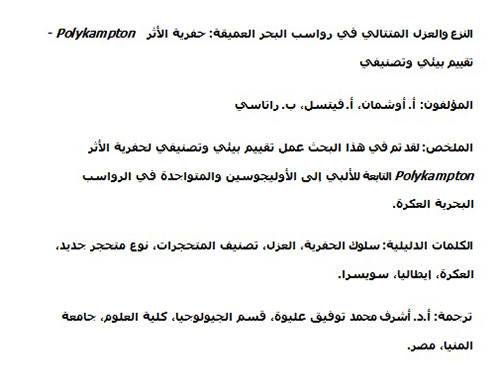Alternating stripmining and sequestration in deep-sea sediments: The trace fossil Polykampton – an ecologic and ichnotaxonomic evaluation
Plain Language Abstract
Polykampton has been until now an enigmatic trace of some invertebrate organisms. It is preserved in Upper Cretaceous to Paleogene deep-sea turbiditic deposits. The type material of Polykampton from Switzerland was known in the literature only from drawings. It has been rediscovered, described and reinterpreted. Polykampton is composed of a horizontal median cylindrical tunnel and lateral lobes that alternate on either side of the tunnel slightly inclined to bedding. Evidently, the tracemaker collected organic-rich mud on the seafloor, stored it in the lobes and used it for feeding especially in times of food deficiency. Differences in morphology of Polykampton allow the recognition of three ichnospecies, two of which are new.
Resumen en Español
Alternando minería y secuestro en sedimentos marinos profundos: la traza fósil Polykampton – una evaluación ecológica e icnotaxonómica
Polykampton Ooster, 1869, comprende trazas fósiles de ambiente marino profundo compuestos de un túnel medial, cilíndrico y horizontal y lóbulos de spreite laterales que se encuentran alternados a cada lado del túnel y están ligeramente inclinados respecto de la estratificación. Los lóbulos en P. alpinum Ooster, 1869, se encuentran estrechamente espaciados y parcialmente recubiertos. En P. guberanum isp. nov., son asimétricos y ampliamente espaciados. En ambas icnoespecies, los lóbulos se encuentran generalmente debajo del túnel medial. En P. multiflabellatum isp. nov., los lóbulos se extienden desde las curvas externas del túnel medial que corre por debajo. Polykampton es una estructura producida por un organismo vermiforme que ocupa un nivel endobentónico profundo. El productor evidentemente secuestraba sedimento rico en materia orgánica del fondo marino, lo almacenaba en los lóbulos y lo procesaba luego minándolo para alimentarse, especialmente en momentos de baja disponibilidad de alimento en el fondo marino. Polykampton se registra en depósitos marinos, principalmente turbidíticos, del Albiano superior al Oligoceno.
Palabras clave: comportamiento fósil; secuestro; icnotaxonomía; nueva icnoespecie; flysch; Italia; Suiza
Traducción: Diana Elizabeth Fernández
Résumé en Français
Alternance entre surcreusement laminaire et séquestration dans les sédiments marins profonds : la trace fossile P. – une évaluation écologique et ichnotaxonomique
Polykampton alpinum Ooster, 1869, P. guberanum isp. n., et Polykampton multiflabellatum isp. n. sont des traces fossiles de la mer profonde. Elles sont composés par un tunnel horizontal cylindrique et des lobes limbales latérales alternantes des deux cotés. Les lobes chez P. alpinum sont étroitement éspacés et partiellement bardés. Chez P. guberanum elles sont asymmetriques et largement éspacés. Chez les deux ichnotaxa, les lobes se trouvent géneralement sous le tunnel. Chez P. multiflabellatum, les lobes étendent de la partie éxterieure du tunnel median et le tunnel cours sous les lobes. Polykampton est une structure produit par un organisme vermiforme vivant dans une hiérarchie profonde. Le ver sequestrait du sediment riche en matière organique à la surface, stockés dans les lobes. Il le processait plus tard en exploitation minière pour manger, surtout en temps de basses disponibilité de nourriture sur le fonds marin. Polykampton est présent de l’Albien supérieur à l’Oligocène dans la mer profonde, particulièrement dans des turbidites.
Mots-clés: « comportement fossile, séquestration, ichnotaxonomie, nouvelle ichnoespèce, flysch, Italie, Suisse
Translator: Authors
Deutsche Zusammenfassung
Abwechselnd schichtgebundene Sedimentnutzung und in Tiefsee-Sedimenten: Das Spurenfossil Polykampton – eine ökologische und ichnotaxonomische Abklärung
Polykampton alpinum Ooster, 1869, P. guberanum isp. n., und Polykampton multiflabellatum isp. n. sind Spurenfossilien, die in Tiefsee-Sedimenten vorkommen. Diese Spuren bestehen aus einem horizontalen, zentralen Tunnel mit zylindrischem Querschnitt und seitlichen lappenartigen Spreiten, die auf beiden Seiten des Tunnels abwechselnd angelegt sind. Die Spreiten von P. alpinum liegen dicht beieinander und überlappen sich teilweise. Bei P. guberanum sind sie Spreiten weit auseinander und asymmetrisch angelegt. Bei beiden Ichnotaxa befinden sich die Spreiten in der Regel unterhalb des Tunnels. Bei P. multiflabellatum verläuft der Tunnel unter den Spreiten, die an der konvexen Aussenseite von Tunnelkurven ansetzen. Polykampton ist eine Struktur, die von einem "wurm"-artigen Organismus erzeugt wird, der recht tief im Sediment lebt. Der Wurm nimmt organisch-reiches Material von der Sedimentoberfläche und speichert es in den Spreiten, um sich dann später davon zu ernähren, insbesondere in Zeiten, wenn das Nahrungsangebot auf dem Meeresboden gering ist. Polykampton ist bisher in Tiefsee-Sedimenten mit Alter spätes Albium bis Oligozän bekannt – hauptsächlich in turbiditischen Ablagerungen.
Schlüsselworte: Fossiles Verhalten; "Hamstern"; Spurenfossiltaxonomie; neue Spurenfossilart; Flysch Italien; Schweiz
Translator: Authors
Arabic

Translator: Ashraf M.T. Elewa
Polski
Naprzemianległe, pasmowe przerabianie osadu i sekwestracja w głębokim morzu – skamieniałość śladowa Polykampton oraz jej analiza ekologiczna i ichnotaksonomiczna
Polykampton Ooster, 1869, obejmuje głębokowodne skamieniałości śladowe złożone z poziomych, cylindrycznych tuneli oraz ułożonych przemiennie po obu stronach tunelu bocznych, roztokowych lobów, które są lekko nachylone do uławicenia. Loby P. alpinum Ooster, 1869, są ściśle upakowane i ułożone dachówkowo. W P. guberanum isp. nov. loby są asymetryczne i rzadko rozłożone. W obu ichnogatunkach loby są położone generalnie poniżej środkowego tunelu. W P. multiflabellatum isp. nov., loby rozprzestrzeniają się z zewnętrznej strony zakoli centralnego tunelu który biegnie poniżej lobów. Polykampton jest struktura produkowaną przez robakokształtne organizmy zajmujące głębokie piętra w osadzie. Organizmy te zbierały z dna osad bogaty w materię organiczną, gromadziły go w lobach I przerabiały go później, głównie w czasach niskiej dostępności pożywienia na dnie. Polykampton występuje w głębokowodnych, głównie turbidytowych osadach od górnego albu po oligocen.
Słowa kluczowe: zachowanie kopalne; sekwestracja; ichnotaksonomia; flisz; Włochy; Szwajcaria
Translator: Authors

